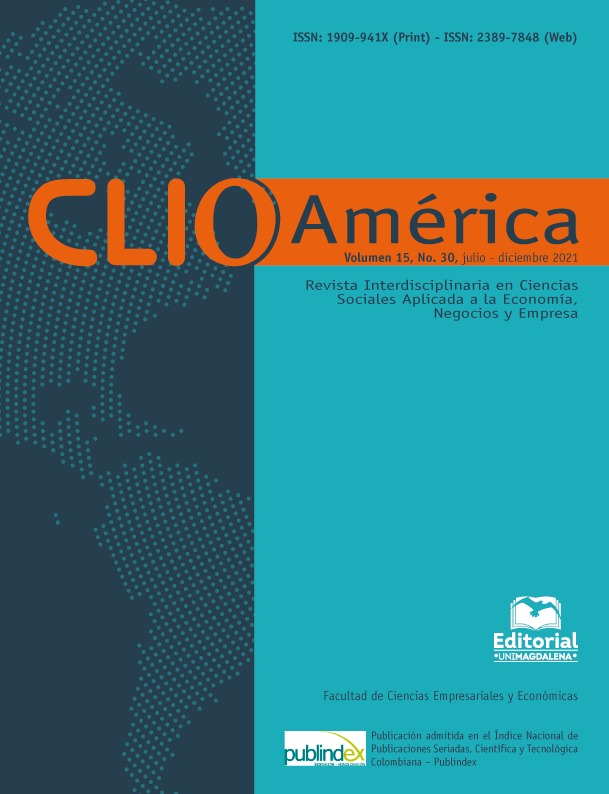Abstract
This article shows a reflection from the interpretive methodology of the impact that emerging technological advances can offer on the relationship between micro and macro accounting. Previously this connection was thought utopian, but current technological advances that allow carrying out tasks such as collecting, storing, processing, transferring and transmitting a large amount of information, highlight the end of the impossibility. Today you can speak of a different scenario, as the results show that large-scale data manipulation technologies are increasingly accurate and robust, given that interconnectivity, analysis and systematization systems, such as Blockchain, artificial intelligence and big data, reveal the integration of individual activities understood as micro to general or collective ones as macro. These technologies offer the possibility of a new structure for data manipulation systems, allowing us to envision a revolution in the administration of financial and accounting information.References
Barbieri, E. (1993). La previsión humana y social: estudios sobre los futuros. Fondo Cultura Económica.
Benito, R., Losada, J., Galeano, J. y Rebollo, M. (2019). Detección de nodos tramposos en procesos de consenso de redes. I Workshop en Ciencia de Datos en Redes Sociales, 1011-1016. http://bit.ly/3nzWWtb
Bertalanffy, L. V. (1976). Teoría general de los sistemas. Fondo de Cultura Económica.
Cañibano, L. (1982). Contabilidad: análisis contable de la realidad económica. Ediciones ICE.
Camargo-Vega, J. J., Camargo-Ortega, J. F. y Joyanes-Aguilar, L. (2015). Conociendo Big Data. Revista Facultad de Ingeniería, 24(38), 63-77. https://bit.ly/2MPaVP6
Concari, S. B. (2014). Tecnologías emergentes ¿cuáles usamos? Latin American Journal of Physysics Education, 8(3), 494-503. https://bit.ly/39p5H4m
Delgadillo, R. D. (2002). El sistema de información contable. Universidad del Valle.
Del Val, J. (2012). Industria 4.0: la transformación digital de la industria española. Universidad de Deusto. https://bit.ly/2MZpO1t
Dhar, V. (2017). Robots will soon taxes bye bye accounting jobs. Wired. http://bit.ly/39ldUqa
Durán, L. E. (2021). El enfoque interpretativo: una nueva manera de ver la contabilidad. Actualidad Contable Faces 24(42), 95-112. https://www.redalyc.org/journal/257/25767348004/html/
García-Casella, L. C. (2007). Particularidades de la contabilidad macrosocial frente a la contabilidad microsocial. Universidad de Buenos Aires. https://bit.ly/3q8grKY
García, A. (1995). Notas sobre la teoría general de sistemas. Revista General de Información y Documentación 5(1), 197-213. http://bit.ly/2KdEyJa
García, M. (2002). Contabilidad y circulación económica. Una visión nueva y unificada de la contabilidad. Pearson Educación.
George, G., Haas, M. R. y Pentland, A. (2014). Big data and management: From the editors. Academy of Management Journal, 57(2), 321-326. https://bit.ly/2XvBURW
Gildardo-Campero, H. V., West Churchman, C., Gómez Acevedo, R., y Coombs, P. H. (1983). Introducción a la teoría de sistemas. SENA. https://bit.ly/3i9ubCK
Godet, M. (2000). Prospectiva estratégica: Problemas y métodos. Prospektiker. https://archivo.cepal.org/pdfs/GuiaProspectiva/Godet2007.pdf
Grange, E. (2016). Delphitools. http://bit.ly/39vXKum
Hauque, S. y Di Russo, L. (2012). Contabilidad social: Eje integrador de las ramas contables. Escritos Contables y de Adiministración, 3(2), 75-114.
Henao, J. C. y Pinzón-Camargo, M.A. (2021) ¿Cuarta revolución industrial? Contribuciones tecnosociales para la transformación social. Universidad Externado de Colombia. https://bdigital.uexternado.edu.co/handle/001/3759
Hernández, R. E. y Céspedes, J. (2020). Bioeconomía: una estrategia de sostenibilidad en la cuarta revolución industrial. RIIARn, 7(2), 126-133. http://www.scielo.org.bo/pdf/riiarn/v7n2/v7n2_a15.pdf
Hernández-Sampieri, R., Fernández Collado, C. y Baptista Lucio, M. del P. (2014). Metodología de la investigación. McGraw Hill.
Ijiri, Y. y Hiroyuki, I. (1975). Quadratic cost-volume relationship and timing of demand information. The Accounting Review, 50(1), 138-139. https://bit.ly/3oCOSt5
Leiva, T. A., Calvo, B. y Conejo, F. A. (2020). Inteligencia artificial para la transformación digital en toma de decisiones. Revista de la Facultad de Ingenierías y Tecnologías de Información y Comunicación, 15-25. http://bit.ly/35wIE6q
Lemos, J. E. (2004). La contabilidad un saber sin medición. Cuadernos de Administración, 31, 10-27. https://bit.ly/35zu1zo
Lizcano, J. (2019). Una proyección multidisciplinar de la energía: su modelización macrocontable. Encuentros Multidisciplinarios, 62, 1-5. https://repositorio.uam.es/handle/10486/688473
Macías, H. A., Farfán, M. A. y Rodríguez, B. A. (2020). Contabilidad digital: los retos del blockchain para académicos y profesionales. Revista Activos, 18(1), 9-23. https://doi.org/10.15332/25005278/6152
Mattessich, R. (2002). Contabilidad y métodos analíticos: medición y proyección del ingreso y la riqueza en la microeconomía y en la macroeconomía. Editorial La Ley.
Medina, J. E. (2006). Visión compartida de futuro. Universidad del Valle. https://bit.ly/39qpDDR
Ministerio de Tecnologías de la Información y Comunicaciones - MINTIC (2020). Guía con lineamientos generales para el uso de tecnologías emergentes. https://mintic.gov.co/portal/715/articles-149186_recurso_5.pdf
Mohamed, B; Elkafi, H. y Zied, B. (2017). Internet of things and supply chain management: a literature review. International Journal of Production Research, 57, 4719-4742. https://doi.org/10.1080/00207543.2017.1402140
Morgan, J. (2020). La resiliencia: habilidad esencial para hacerle frente a la cuarta revolución industrial. Revista Nacional de Administración, 11(1). 21-31. https://www.scielo.sa.cr/pdf/rna/v11n1/1659-4932-rna-11-01-21.pdf
Nakamoto, S. (2008). Bitcoin: a peer-to-peer electronic cash system. http://bit.ly/3bwcJa4 /
Nordström, T. (1988). Moses macro accounting system: updating procedures. Econstor, 196, 2-47. https://www.ifn.se/wfiles/wp/wp196.pdf
Organización para la Cooperación y el Desarrollo Económicos - OCDE, (2019). Estado de la técnica en el uso de tecnologías emergentes en el sector público. https://ialab.com.ar/wp-content/uploads/2020/05/OECD-2019-Estado-de-la-te%CC%81cnica-en-el-uso-de-las-tecnologi%CC%81as-emergentes-en-el-sector-pu%CC%81blico.pdf
Parkin, M., Esquivel, G. y Muñoz, M. (2007). Macroeconomía. Pearson Educación. https://bit.ly/3icZlsL
Parrondo, L. (2018). Tecnología blockchain, una nueva era para la empresa. Revista de Contabilidad y Dirección, 27, 11-31. https://bit.ly/2LrmWtF
Postner, H. H. (1986). Microbusiness accounting and macroeconomic accounting: the limits to consistency. The Review of Income and Wealth, 32(3), 217-244. https://bit.ly/38CAThu
Reyes, H. R. (2017). Inteligencia de negocios aplicada desde Big Data como herramienta para analizar el presupuesto nacional de Guatemala del ejercicio fiscal 2016 [tesis de licentiatura, Universidad de San Carlos de Guatemala]. Repositorio del Sistema Bibliotecario. http://bit.ly/2LNKlFO
Rincón, C. (2016). La contabilidad como juego de lenguaje. Cuadernos de Administración, 32(55), 33-46. https://bit.ly/2LqI1EH
Sánchez, J. y Pincay, D. (2013). La contabilidad pública en América Latina y el devengo en Ecuador. Analítika. Revista de Análisis Estadístico, 6(2), 19-29. https://bit.ly/35wRukC
Venegas, J. (2012). De la macro a la microcontabilidad. Propuesta de un modelo de datos integrador. Capic Review 10(2), 65-81. http://bit.ly/3bFiuCe
Yu, S. C. (1957). Macroaccounting and some of its basic problems. The Accounting Review 32(2), 264-272. https://www.jstor.org/stable/241485?seq=1
Yu, S. C. (1996). Microaccounting and macroaccounting. The Accounting Review, 41(1), 8-20. https://www.jstor.org/stable/242517?seq=1

This work is licensed under a Creative Commons Attribution-NonCommercial-ShareAlike 4.0 International License.

